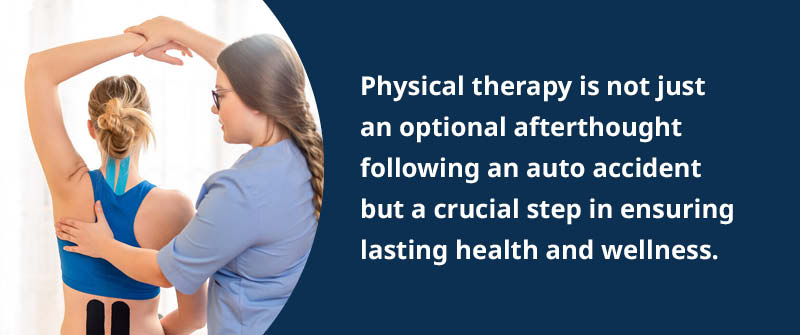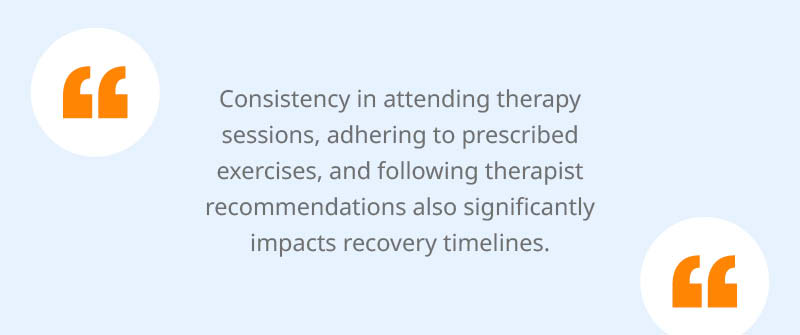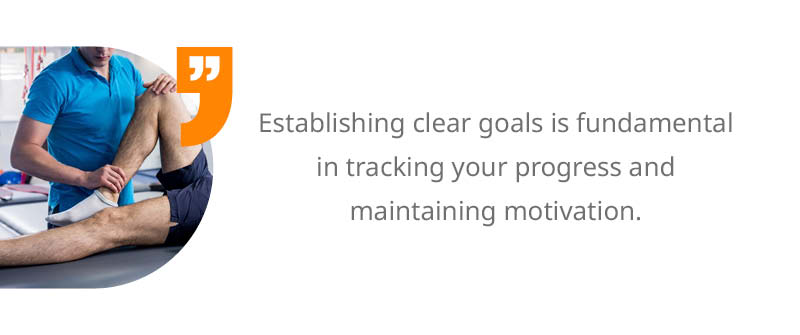
Why Is Physical Therapy Crucial After an Auto Accident?
Physical therapy is crucial after an auto accident because it plays a significant role in facilitating recovery, alleviating pain, and restoring function. Engaging in physical therapy soon after an accident can help prevent chronic pain and long-term health issues, ensuring a quicker and more complete recovery. Furthermore, physical therapy uses natural healing methods that align with the body’s capabilities, minimizing the need for medication and invasive procedures.
Guide to Physical Therapy After an Auto Accident: Importance of Restoring Mobility
One of the primary goals of physical therapy is to restore mobility. Following an auto accident, victims often experience stiffness, reduced range of motion, and difficulty performing everyday activities. A physical therapist will create a personalized treatment plan focused on stretching, strengthening, and mobilizing affected areas. By gradually reintroducing movement, you can regain flexibility and build strength, ultimately restoring your ability to move freely and with confidence. Physical therapy aims to restore mobility, strength, and function, ensuring that you can return to your daily activities as fully as possible. Targeted strengthening exercises not only help you build strength but also prevent future injuries by improving the overall support and stability of your body.
Natural Pain Relief Methods
Pain management is a central focus of physical therapy after an auto accident, utilizing various pain management techniques to address discomfort and support recovery. Instead of relying solely on pain medications, which may have side effects, therapy employs methods such as manual therapy, heat and cold treatments, and ultrasound to reduce discomfort. These approaches encourage the body’s natural healing processes and are aimed at treating the underlying cause of pain rather than merely masking symptoms. This holistic approach can lead to more sustainable and long-lasting pain relief.
Preventing Long-Term Health Issues
Perhaps one of the most compelling reasons to pursue physical therapy after an auto accident is to prevent long-term issues. Untreated injuries, no matter how minor they may seem initially, can lead to chronic pain conditions, altered postures, and functional limitations down the line. Early intervention through physical therapy helps address these issues before they become permanent. By working with a skilled therapist, you can also learn exercises and get advice on posture and ergonomics that will protect you from further injury. Physical therapy not only addresses your current injuries but also helps prevent further injuries by improving your strength, stability, and movement patterns.
In summary, physical therapy is not just an optional afterthought following an auto accident but a crucial step in ensuring lasting health and wellness. By embracing this proactive approach, accident victims can appreciate both immediate relief and ongoing health benefits. Schedule your appointment today at Bull City PT’s Charlotte, Durham or Brier Creek office to schedule a personalized physical therapy plan designed just for you.

How Does Physical Therapy Help in Auto Accident Injury Recovery?
Physical therapy is a vital component of recovery after an auto accident as it addresses a range of injuries such as whiplash, soft tissue injuries, back and spinal injuries, and concussions. These are among the most common injuries seen after car accidents, and understanding these common injuries is crucial for effective treatment. Physical therapy is tailored to address the specific injuries sustained in each accident, ensuring that each patient receives care suited to their needs. It is important to note that physical therapy addresses both visible and less obvious physical injuries resulting from auto accidents. Many auto accident injuries often require specialized rehabilitation to achieve optimal recovery. Each car accident injury may require a unique approach to recovery, highlighting the importance of individualized treatment plans. By focusing on tailored treatment plans, physical therapy helps to expedite the healing process, reduce pain, and restore functionality, enabling individuals to regain their normal lifestyle more effectively.
Addressing Whiplash and Soft Tissue Injuries
Whiplash is a common cervical injury that occurs due to sudden acceleration-deceleration motions, often seen in rear-end car collisions. Physical therapy focuses on restoring range of motion and reducing inflammation through manual therapy, specific stretching exercises, and postural retraining. Whiplash frequently leads to neck pain, stiffness, and discomfort; early intervention is crucial to address neck pain and prevent chronic issues from developing. Additionally, soft tissue injuries, such as muscle strains and ligament sprains, benefit from modalities like ultrasound therapy, which enhances tissue healing and reduces pain.
Techniques for Back and Spinal Injury Relief
Back and spinal injuries are serious concerns following an accident, often leading to prolonged discomfort if left untreated. Spinal cord injuries, which can result from severe trauma in car accidents, require immediate medical attention and specialized rehabilitation to prevent long-term complications. Physical therapy employs techniques such as spinal stabilization exercises, core strengthening, and ergonomic corrections to alleviate pain and improve spinal health. Therapists also use manual therapy to improve mobility and relieve tension in affected areas, fostering a healthy spine necessary for daily activities.
Management of Concussions through PT
Concussions, although primarily associated with sports, are also common in car accidents. Physical therapy plays an important role in managing concussions by incorporating vestibular rehabilitation exercises that address balance problems, along with cognitive exercises to enhance focus and mental clarity. Education on activity pacing and graduated return to activities ensures that concussion symptoms are managed effectively without causing further harm. Addressing acute pain promptly is essential for effective recovery from concussions and other accident-related injuries.
By incorporating tailored interventions and focusing on a holistic recovery approach, physical therapy not only mitigates the immediate symptoms post-accident but also prevents potential long-term complications such as chronic pain or reduced mobility.
What’s The Timeline for Post-Accident Physical Rehabilitation?
The timeline for post-accident physical rehabilitation can vary significantly based on the severity of injuries, individual health conditions, and the effectiveness of the physical therapy approach. Generally, physical therapy may last anywhere from a few weeks to several months. Early and regular therapy can enhance recovery outcomes, helping individuals regain mobility and strength while also preventing long-term disabilities.
Monitoring recovery progress throughout the rehabilitation process is essential to ensure that treatment is effective and adjustments are made as needed. Starting physical therapy as soon as possible after an accident can significantly improve recovery outcomes and reduce the risk of complications.
Typical Phases of Recovery
Post-accident rehabilitation typically unfolds in several phases. Initially, the focus is on reducing pain and inflammation commonly present after an accident. It is important to begin physical therapy as soon as acute symptoms allow to facilitate optimal recovery. This phase might last from a few days to a couple of weeks. Once acute symptoms are managed, therapy transitions into a rehabilitation phase focused on restoring mobility, strength, and flexibility. This phase could take several weeks or even months, depending on the injury’s complexity. Finally, the return-to-normal-activity phase focuses on increasing endurance and ensuring patients can resume their daily routines safely. Overall, patience and perseverance during each phase are crucial for successful recovery.
Factors Influencing Rehabilitation Duration
Several factors contribute to the length and success of rehabilitation following an auto accident. The injury’s severity is a primary consideration; minor injuries may require a brief course of therapy, whereas severe injuries such as fractures or significant soft tissue damage could necessitate extended treatment. Additionally, personal health, age, and activity level all play roles in recovery speed. Younger individuals or those with higher fitness levels often experience quicker recoveries. Consistency in attending therapy sessions, adhering to prescribed exercises, and following therapist recommendations also significantly impacts recovery timelines. Lastly, psychological factors like motivation and mental health status can influence rehabilitation, highlighting the importance of comprehensive care approaches. Failing to follow recommended rehabilitation can result in further complications and delayed recovery.

Choosing the Right Physical Therapist After a Car Accident
After experiencing a car accident, choosing the right physical therapist becomes a crucial step in your recovery journey. The therapist you select can significantly impact your healing process, so it’s important to make an informed decision. Selecting a qualified physical therapist ensures you receive effective, personalized care tailored to your specific needs. Pain management specialists may also be involved in your care as part of a comprehensive recovery team, offering additional support for pain relief. It is especially valuable to choose a therapist experienced in treating car accident injuries, as their specialized expertise can greatly enhance your recovery. Seeking a therapist with the right expertise and approach will not only help in reducing pain but also in regaining mobility and preventing future complications.
Qualities to Look for in a Therapist
When searching for a physical therapist post-accident, you want someone who has the right qualifications and a proven track record of helping patients in similar scenarios. It is beneficial to choose a therapist who specializes in injury recovery, particularly those injuries common in auto accidents, like whiplash or back injuries. Look for a licensed professional who is also patient and communicative, as these traits are essential in ensuring a supportive and encouraging treatment environment. Physical therapists design personalized rehabilitation plans and closely monitor patient progress to ensure optimal recovery after a car accident. Furthermore, they should have a knack for developing personalized treatment plans tailored to your specific needs.
Questions to Ask Potential Therapists
Before committing to a physical therapist, it’s wise to prepare a set of questions. Ask about their experience with similar injuries and inquire into their typical treatment plans and success stories. Ensure they are familiar with the latest recovery techniques and express a willingness to adapt their methods to suit your progress and comfort levels. Understanding when to seek physical therapy is crucial for timely and effective recovery, so be sure to discuss the signs and timing that indicate you should begin treatment. In addition, verify their availability for appointments that fit your schedule and discuss the expected duration of your therapy sessions.
Importance of Specialized Experience
Specialized experience is vital when choosing a therapist because it ensures they possess an understanding of the nuanced challenges that come with car accident injuries. A therapist with extensive experience in auto accident recovery will be adept at detecting subtle issues that could escalate if not treated properly. This specialized experience is especially important for addressing injuries sustained in a car crash, where prompt and knowledgeable care can make a significant difference in recovery. They will also have refined their techniques in achieving optimal recovery outcomes with minimal discomfort. Ultimately, with specialized experience, a therapist can become an invaluable partner in your journey to full recovery.
What Can You Expect During Your First Physical Therapy Session?
When embarking on your journey to recovery with physical therapy after an auto accident, the first session can be both an enlightening and reassuring experience. You can expect your first appointment to lay the foundation for future treatments, as it typically involves a comprehensive evaluation and the development of a personalized treatment plan tailored to your specific needs and goals. This initial assessment is also crucial for identifying hidden injuries that may not be immediately obvious, ensuring that all potential issues are addressed early in your recovery process.
Initial Assessment Procedures
Your first physical therapy session will likely involve a detailed initial assessment. This assessment is crucial as it allows the therapist to understand the extent of your injuries and formulate a detailed plan for your recovery. You’ll discuss your medical history, the circumstances surrounding your accident, and your current symptoms. It is important to bring accurate medical records to this assessment, as they provide essential documentation to support your recovery plan. The therapist might also perform physical tests to evaluate your range of motion, strength, and pain levels. This step is about creating a clear picture of your physical state post-accident.
Typical Session Flow
Once the initial assessment is over, the physical therapist will explain the typical flow of your future sessions. Following the evaluation, you might perform a few initial exercises or stretches based on your condition. These therapeutic exercises are specifically designed to aid recovery and improve mobility from the outset. The therapist will demonstrate these exercises and ensure you can perform them correctly to avoid further injury. They will also likely introduce you to any tools or equipment that might be used in your therapy, such as resistance bands or balance boards, helping you feel more comfortable and confident in the environment.
Establishing Treatment Goals
Another critical component of the first session involves setting treatment goals. Your therapist will work with you to establish short-term and long-term objectives aimed at restoring your function and alleviating pain. Establishing clear goals is fundamental in tracking your progress and maintaining motivation. You will have the opportunity to convey any personal aspirations related to your recovery, from returning to work activities to participating in favorite pastimes—your treatment plan will consider your lifestyle and ambitions as well.

What Exercises Can You Expect in Auto Accident Physical Therapy?
After an auto accident, it’s crucial to engage in exercises during physical therapy to regain strength, mobility, and quality of life. You can expect to perform a variety of exercises designed to address your specific needs and aid in your recovery. These exercises will be tailored to the injuries you sustained, whether they involve soft tissue damage, joint injuries, or support for whiplash recovery.
Physical therapy addresses a wide range of motor vehicle accident injuries, providing comprehensive care for various trauma types. One of the main goals of these exercises is to manage pain effectively and support your recovery process. Many patients experience significant relief from pain and improved function through targeted physical therapy exercises.
Common Stretching Techniques
Stretching exercises form the backbone of many physical therapy programs, especially after auto accidents. Such exercises help improve flexibility and prevent stiffness that often follows an injury. Stretching is also effective in alleviating muscle tension that can develop after an accident. Both stretching and massage therapy are commonly used to reduce muscle tension and promote relaxation during recovery. Additionally, improved blood flow from stretching accelerates healing and helps reduce inflammation. Your therapist might guide you through gentle neck stretches if you’re dealing with whiplash or help you perform hamstring and quadriceps stretches to support any leg injuries. These exercises usually start with low intensity and gradually increase as your body adapts, ensuring a safe and sustainable recovery. Stretching also improves blood circulation, promoting healing and reducing soreness.
Strength-Building Exercises
Building strength is another pivotal component of physical therapy after an auto accident. Without strong muscles to support healing tissues, the risk of re-injury or the development of chronic problems increases. Strengthening exercises often focus on the core, back, and limbs, targeting areas weakened by the trauma of an accident. You may employ simple resistance bands, light weights, or even your body weight to build strength progressively. These exercises are crucial, not only for recovery but also for preventing long-term issues and enhancing overall physical resilience. Strengthening muscles through targeted exercises helps reduce the risk of future injuries by improving stability and support. Proper rehabilitation and these exercises can also prevent chronic pain from developing after an accident.
Balance and Coordination Activities
After the trauma of a car accident, restoring your balance and coordination is essential for resuming daily activities and preventing falls. Balance and coordination exercises can range from simple activities such as standing on one leg to more dynamic movements that integrate various muscle groups. Exercises like these help recalibrate the nervous system and improve proprioception — the body’s ability to sense movement, action, and location — which can be disrupted after an injury. These activities also play a significant role in regaining confidence in your body’s abilities.
Incorporating balance and coordination exercises is crucial for comprehensive physical recovery after an accident, as they address both mobility and overall well-being.
What’s The Role of Insurance in Physical Therapy After Car Accidents?
Understanding the role of insurance in the aftermath of a car accident is crucial in ensuring you receive the necessary care without a financial burden. Insurance can cover a myriad of healthcare costs, including physical therapy, thus playing a pivotal role in your recovery. Most auto insurance policies include car accident injury treatment such as physical therapy, which is essential for a full recovery. Insurance also helps cover medical expenses related to your accident, reducing out-of-pocket costs. This comprehensive support is vital for the overall process of car accident recovery, ensuring you have access to the treatments and services you need. However, navigating insurance claims can be complex, requiring careful attention to details to ensure all parties involved are on the same page.
Understanding Insurance Coverage
Insurance plans, whether personal health insurance or auto insurance, typically offer coverage for physical therapy following a car accident. This coverage often includes treatment for a range of auto accident injuries, such as whiplash, back pain, and soft tissue damage. This coverage is vital as it enables you to receive customized rehabilitation without immediate out-of-pocket expenses. Understanding your policy’s provisions, including any limits or restrictions, can help in planning your recovery journey effectively.
Researching your plan and having a conversation with your insurance provider can clarify what is accessible to you. Reach out to your insurance representative and ask detailed questions about what exactly your policy covers regarding physical therapy, any requisite co-pays, and whether there are caps or limitations to the number or type of treatments offered. Doing so will prepare you best to maximize your benefits.
Tips for Navigating Claims
Navigating the claims process can be daunting, especially when recovering from an accident. Start by collecting all necessary documentation, including medical reports and therapy plans, which substantiate your need for ongoing treatment. Be sure to include records of any specialized treatments, such as electrical stimulation, as these may be important for your claim. Detailed record-keeping not only aids in processing claims smoothly but also in resolving any disputes that might arise.
Filing claims as promptly as possible and adhering to any stipulated timelines set by your insurer is vital. If your insurance requires pre-authorization for physical therapy treatments, ensure you have all approvals in place to prevent potential payment denials.

Impacts on Legal Settlements
Engaging in physical therapy can have a significant impact on the settlement process post-accident. Regular therapy sessions, coupled with comprehensive documentation, provide a clear record of your injury’s severity and recovery needs. This documentation can potentially support your case in legal claims by offering evidence of persistent efforts to recover and the necessity for long-term or ongoing care. Ensuring proper healing through therapy is essential not only for optimal recovery but also for achieving successful legal outcomes.
In some scenarios, physical therapy can increase your settlement. If you can demonstrate that your recovery process is extensive and financially taxing, this may be factored into any financial negotiations or compensation you seek from those deemed at fault. Always consult with both your legal advisor and insurer for detailed advice tailored to your situation.
Tips for a Faster Recovery After an Auto Accident
Recovering from an auto accident can be a challenging process, both physically and emotionally. Fortunately, there are several strategies that can aid in expediting your recovery and preventing long-term complications. By prioritizing self-care, maintaining consistency with therapy, and making informed lifestyle choices, you can optimize your healing journey and return to your active lifestyle as soon as possible.
Supporting physical healing through these strategies is essential for a full recovery. These approaches are designed to promote healing and speed up your recovery process. The comprehensive process of recovering from car accident injuries involves addressing both physical and emotional aspects to ensure the best possible outcome.
Self-care Recommendations
Self-care is a crucial element in accelerating recovery after an auto accident. Ensure you’re getting enough rest, as sleep is vital for tissue repair and overall healing. Implementing stress management techniques such as deep breathing, meditation, and gentle yoga can also support emotional well-being during recovery. Since a car accident is often a traumatic event, seeking mental health support or professional counseling may be beneficial for emotional recovery. Additionally, applying cold and heat therapy can alleviate soreness and reduce inflammation in the acute stages of injury.
Staying Consistent with Therapy
Consistency with physical therapy sessions plays a pivotal role in a faster recovery. Each session builds upon the previous one to improve mobility, strength, and functionality. It’s important to adhere to the prescribed therapy regimen and actively engage in any recommended home exercises. This consistent effort not only accelerates recovery but also helps in preventing potential setbacks. Seeking physical therapy early and staying consistent with your sessions are key steps to achieving optimal recovery. Communicate regularly with your therapist to adjust exercises as needed to ensure a balanced and progressive rehabilitation.
Diet and Lifestyle Considerations
The role of nutrition in recovery from injuries is often underestimated. A balanced diet rich in vitamins and minerals can support the body’s repair processes. Omega-3 fatty acids, found in fish and flaxseeds, are known for their anti-inflammatory properties, which can be beneficial in reducing injury-related inflammation. Staying hydrated is equally important, as it aids in circulation and helps the body heal more efficiently. Additionally, avoiding alcohol and smoking is advisable, as these can hinder the body’s recovery capabilities.
By incorporating these tips into your recovery plan, you give your body the best chance at healing efficiently and minimizing the risk of long-term complications. Remember, every small step you take can significantly impact your path to recovery, so stay positive and don’t hesitate to reach out to your healthcare providers for support and guidance.
FAQs About Physical Therapy After An Auto Accident
Embarking on a journey to recovery after an auto accident can be overwhelming, and naturally, you may have some questions about physical therapy. Here, we will address some of the most common concerns to help clear any uncertainties and empower you to take charge of your rehabilitation process confidently.
Common car accident injuries addressed in physical therapy include whiplash, back pain, neck injuries, soft tissue injuries, and fractures, ranging from minor to severe.
How long should I go to physical therapy after a car accident?
This varies greatly depending on the severity of your injuries, personal recovery goals, and response to treatment. Typically, the duration of physical therapy is determined by your therapist, who will closely evaluate your progress and adjust the plan accordingly. It is essential to commit to the prescribed schedule to maximize healing benefits and prevent any potential setbacks.
Your therapist will help establish realistic milestones and regularly reassess your condition to ensure optimal recovery. Remember, each case is individual, and timelines can range from several weeks to a few months.
What is the best physical therapy after a car accident?
The best physical therapy is one that is tailored specifically to your needs, addressing the unique injuries you sustained in the accident. A personalized treatment plan will incorporate techniques like stretching, strength training, and perhaps specialized methods like manual therapy, soft tissue mobilization, or even aquatic therapy to facilitate your recovery. Engaging with a therapist who has experience with auto accident recovery can help ensure that your therapy is both effective and safe.
Discuss your concerns and preferences with your therapist to create a plan that not only aids in recovery but also aligns with your comfort and lifestyle.

Will physical therapy increase my settlement?
Physical therapy can factor into your insurance or legal settlement as it documents your commitment to recovery and provides evidence of the extent of your injuries. Comprehensive documentation of your therapy sessions can highlight the necessity and effectiveness of your treatment, potentially influencing the compensation you receive. However, it’s crucial to focus on your health and recovery over financial outcomes.
Engage with your therapist and legal advisor to understand how therapy can play a role in your settlement process, ensuring all treatments are thoroughly recorded.
At Bull City PT, we’re committed to answering your questions and providing the expert care you need. Our personalized approach to physical therapy helps you overcome challenges and confidently return to the activities you love. Begin your journey with us today and experience a tailored path to a fitter, pain-free life.
C






